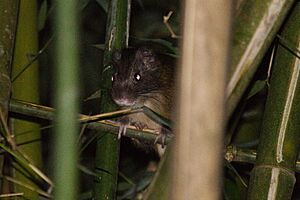Atlantic bamboo rat facts for kids
Quick facts for kids Atlantic bamboo ratTemporal range: Pleistocene to Recent
|
|
|---|---|
 |
|
| Conservation status | |
| Scientific classification | |
| Genus: |
Kannabateomys
|
| Species: |
amblyonyx
|
| Subspecies | |
The Atlantic bamboo rat (Kannabateomys amblyonyx), also known as the southern bamboo rat, is a type of spiny rat. It lives in warm, wet forests in Argentina, Brazil, and Paraguay. This rat is the only known member of its group, called the Kannabateomys genus.
Contents
What Does It Look Like?
The Atlantic bamboo rat can grow to about 25 cm (9.8 in) long, not including its tail. Its tail is even longer, about 32 cm (12.6 in)! It weighs around 475 g (1 lb), which is less than a pound.
Its fur is usually a mix of brown and grey, like many rodents. It gets a bit more reddish-brown on its sides. Its chin and belly are white with a hint of reddish-brown. The first 6 cm (2.4 in) of its tail has a lot of hair, but the rest is mostly bare. It has a clear tuft of hair at the very tip of its tail. When fully grown, this bamboo rat is easy to spot because of its long tail.
Where Does Its Name Come From?
The scientific name Kannabateomys comes from three old Greek words. "Kanna" means "reed" or "cane," "bateo" means "to mount" or "to climb," and "mys" means "mouse" or "rat." So, its name means something like "cane-climbing rat."
The species name amblyonyx also comes from two old Greek words. "Amblys" means "blunt" or "not sharp," and "onyx" means "claw" or "fingernail." This part of its name likely refers to its blunt claws.
Where Does It Live?
This rat is native to South America. You can find it in southeastern Brazil, eastern Paraguay, and northeastern Argentina. It prefers moist forests, especially those near water, that have a lot of dense bamboo plants. It particularly likes the giant bamboo called Guadua angustifolia, which grows in thick patches.
How Does It Live?
The Atlantic bamboo rat is nocturnal, meaning it is active at night. It spends most of its time in trees and bamboos, climbing around, especially near water. Its home area is about 1,000 m2 (1,200 sq yd). If it gets scared, it makes loud squealing sounds. Scientists believe it eats grasses, leaves, young shoots, fruits, and tubers (underground plant parts).
Is It Endangered?
The Atlantic bamboo rat is not a very common animal. For example, in one part of Brazil, there are only about four rats per square kilometer. Since it is active at night, people don't see it very often. However, it lives across a large area, so its total population is thought to be quite big.
In some places, like the state of Minas Gerais in Brazil, its habitat is threatened by forests being cut down. But other major threats have not been found. Because of this, the International Union for Conservation of Nature has listed its conservation status as "least concern." This means it is not currently considered to be in danger of extinction.


